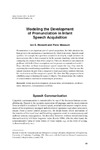Modeling the development of pronunciation in infant speech acquisition.
| dc.contributor.author | Howard, Ian | |
| dc.contributor.author | Messum, P | |
| dc.date.accessioned | 2015-07-18T23:11:34Z | |
| dc.date.available | 2015-07-18T23:11:34Z | |
| dc.date.issued | 2011-01-01 | |
| dc.identifier.issn | 1087-1640 | |
| dc.identifier.issn | 1543-2696 | |
| dc.identifier.uri | http://hdl.handle.net/10026.1/3445 | |
| dc.description.abstract |
Pronunciation is an important part of speech acquisition, but little attention has been given to the mechanism or mechanisms by which it develops. Speech sound qualities, for example, have just been assumed to develop by simple imitation. In most accounts this is then assumed to be by acoustic matching, with the infant comparing his output to that of his caregiver. There are theoretical and empirical problems with both of these assumptions, and we present a computational model- Elija-that does not learn to pronounce speech sounds this way. Elija starts by exploring the sound making capabilities of his vocal apparatus. Then he uses the natural responses he gets from a caregiver to learn equivalence relations between his vocal actions and his caregiver's speech. We show that Elija progresses from a babbling stage to learning the names of objects. This demonstrates the viability of a non-imitative mechanism in learning to pronounce. | |
| dc.format.extent | 85-117 | |
| dc.format.medium | ||
| dc.language | eng | |
| dc.language.iso | eng | |
| dc.publisher | Human Kinetics | |
| dc.subject | Humans | |
| dc.subject | Imitative Behavior | |
| dc.subject | Infant | |
| dc.subject | Language Development | |
| dc.subject | Neural Networks (Computer) | |
| dc.subject | Phonation | |
| dc.subject | Phonetics | |
| dc.subject | Reinforcement (Psychology) | |
| dc.subject | Speech | |
| dc.subject | Speech Perception | |
| dc.subject | Speech Recognition Software | |
| dc.subject | Verbal Behavior | |
| dc.subject | Verbal Learning | |
| dc.subject | Vocabulary | |
| dc.title | Modeling the development of pronunciation in infant speech acquisition. | |
| dc.type | journal-article | |
| dc.type | Article | |
| plymouth.author-url | http://www.ncbi.nlm.nih.gov/pubmed/21339516 | |
| plymouth.issue | 1 | |
| plymouth.volume | 15 | |
| plymouth.publication-status | Published | |
| plymouth.journal | Motor Control | |
| dc.identifier.doi | 10.1123/mcj.15.1.85 | |
| plymouth.organisational-group | /Plymouth | |
| plymouth.organisational-group | /Plymouth/Faculty of Science and Engineering | |
| plymouth.organisational-group | /Plymouth/Faculty of Science and Engineering/School of Engineering, Computing and Mathematics | |
| plymouth.organisational-group | /Plymouth/REF 2021 Researchers by UoA | |
| plymouth.organisational-group | /Plymouth/REF 2021 Researchers by UoA/UoA11 Computer Science and Informatics | |
| plymouth.organisational-group | /Plymouth/Users by role | |
| plymouth.organisational-group | /Plymouth/Users by role/Academics | |
| dc.publisher.place | United States | |
| dc.identifier.eissn | 1543-2696 | |
| dc.rights.embargoperiod | Not known | |
| rioxxterms.versionofrecord | 10.1123/mcj.15.1.85 | |
| rioxxterms.licenseref.uri | http://www.rioxx.net/licenses/all-rights-reserved | |
| rioxxterms.type | Journal Article/Review |


